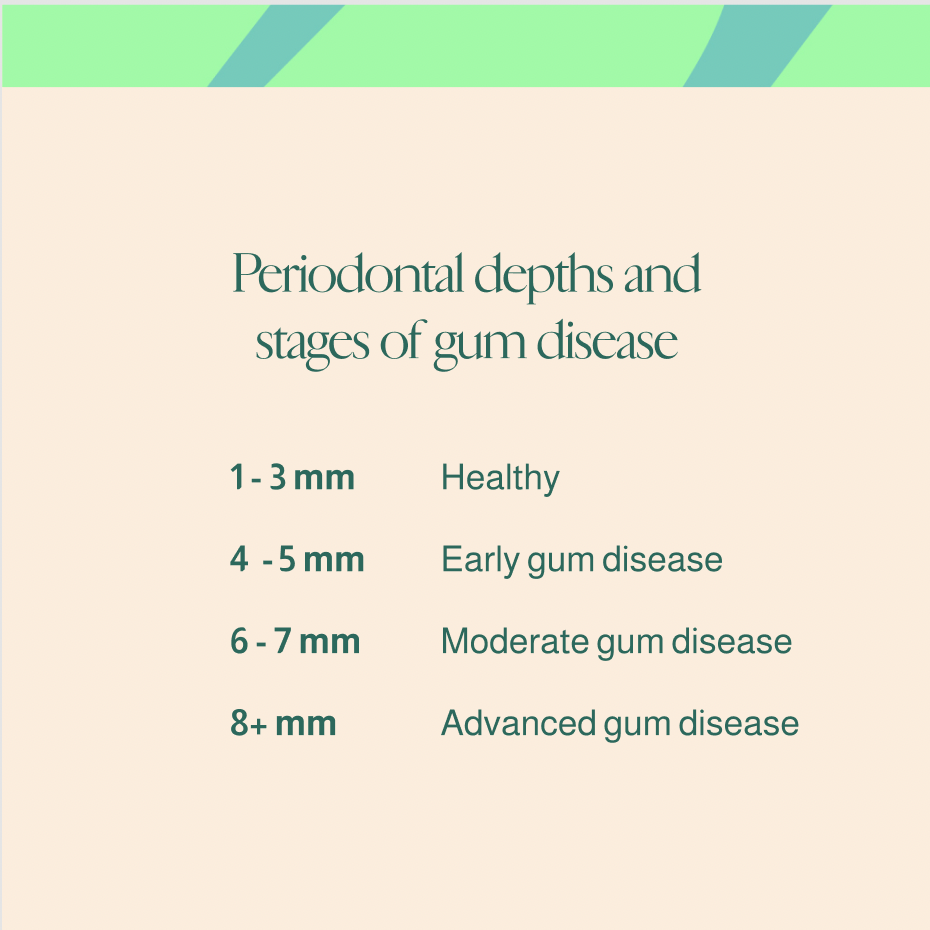8 mm periodontal pockets and gum health explained

It's been a while since your last cleaning because COVID threw a wrench in everybody's routine. You finally get an appointment and after filling out reams of paperwork and waiting for your hygienist to return to the room (did they forget you were in here?) they get to work.
Suddenly they're lightly poking all around your teeth. Every dozen or so jabs they seem to go back to the computer and type in a bunch of stuff, or perhaps call out a random string of numbers. When it's all done your hygienist puts away the tool and says, "FOR SHAME! Your gum pockets obviously show that you DO NOT floss twice a week, more like twice per year. You keep this up and you can kiss your teeth goodbye within the next five years."
Ok, your hygienist probably didn't say that to you. But that's what it felt like. Especially if your periodontal pockets measure more than 4mm.
Sadly perio charting is used by traditional dentists as a scare or shaming tactic rather than a tool to baseline your gum health and understand how to best take care of your natural smile.
If your provider spent more time sharing your information with you, rather than upselling you treatments, here's what they'd explain.
Perio chart - why it's done
Your periodontal chart is one of the key inputs into determining how your mouth is doing. It's a chart measuring how far below your gum line your gum tissue connects to your tooth.
It's conducted with a skinny probe ingrained with millimeter measurement marks. Your clinician will gently insert the probe between your tooth and gum to determine where the gum tissue is connected to your tooth. That number is then recorded in your perio chart.
Since your teeth are round, your clinician will measure your pocket depths at six points around your tooth using a perio probe. Most adults have 28 to 32 teeth (depending on if you have your wisdom teeth), which means your clinician is measuring more than 150 points in your mouth. That's why they might sound like an auctioneer as they do your charting.
Why take so much time to measure your mouth in millimeters? The measurements in your periodontal chart are invaluable inputs to determine if you have periodontitis. But it's not the only factor. Your dentist will also examine your x-rays and gum inflammation to determine if you have periodontitis, and how severe your condition is.
Gum tissue doesn't always get top billing in your smile, but it's critical to keeping your smile straight and brilliant. Because damage to your gum tissue is irreversible, if your pocket depths start to increase the damage will be done. The goal is to stop periodontitis as soon as possible.
Gingival pocket depths
While periodontal pockets aren't the only thing your clinician uses to diagnose periodontal disease (aka gum disease), they are very useful in determining the severity of gum disease.
Periodontal pockets measure from 1 mm to 12 mm. The deeper (bigger) the pockets, the more severe the periodontal disease. Here's a general guide to what the depths of your gum pockets mean:

There are two reasons you want to avoid deep periodontal pockets:
- The larger the pocket, the more easily bacteria can get caught under your gums. That bacteria can flourish and cause infections that will erode your gum tissue and enamel permanently.
- Your toothbrush and floss can't actually reach down to clean below the gum line more than 3 mm. Even if you try to jam your floss down your gums (caution: aggressively flossing can cause gum recession) you won't be able to get down far enough to clear out the gunk.
Because your gum tissue doesn't grow back, an infection means saying goodbye to that gum tissue for good.
One interesting thing is that periodontitis can be localized to certain teeth in your mouth. If you have a few teeth in the back with deep pockets but the rest of your teeth have healthy pockets, then the disease is, currently, localized to those teeth. That means you can get the disease under control in a few teeth before it starts to affect the surrounding teeth.
4mm gum pockets and what you can do about it
If you see your dentist regularly for comprehensive exams, they will continue to measure and track the depths of your gum pockets. If your gum pockets reach the 4 mm range, your dentist or hygienist will let you know, because that's a sign you have early gum disease.
"4 mm pockets are like a warning sign when it comes to gum health," shares Sarah Clark, RDH. "While it's not ideal, it IS the perfect time to address the source of those deepening pockets and either resolve the issue, or maintain it so they don't get deeper."
"Pockets of 4 mm could be due to inflammation, or very early gum disease. In either case, your gums are not as healthy as possible, but you can still manage them and stay healthy if you make the right updates to your at home oral routine."
So if you find out you have 4 mm gum pockets, take a deep breath and it's time to reframe :) It doesn't mean all is lost (or rather, that your gums are lost). It means something about your routine isn't quite a good fit for your unique mouth. Talking about your routine with your clinician and strategizing ways to focus on gum health are two HUGE steps you can take to keep those pockets from getting deeper, or even shrinking them!
Bleeding while flossing can be a thing of the past with the right care
No matter the depths of your pockets, it is NOT normal to bleed when you floss. That's because the most common reason for bleeding gums is gingivitis - aka early gum disease.
Gingivitis is a scary word (few things ending in "-itis' is good), but it's actually a mild and reversible form of gum disease that causes irritation, redness and swelling in your gums near your teeth. Gingivitis is caused by improper or poor oral hygiene - meaning your teeth and gums aren't as clean as your mouth would like them to be. The bleeding is your body's signal that something could be better.
Improving your at home oral hygiene is one big step. The other is seeing your dentist for professional cleanings as often as your body needs.
"For some people, the ideal number of cleanings is two per year, but for many others the ideal number of cleanings can be three or four per year. It depends on the mouth," explains Sarah Clark, RDH.
That's why membership-based dental care with unlimited cleanings is the way to go to keep your mouth healthy. If you're in NYC check if our membership is right for you. Our first studio is open, and we're just getting started revolutionizing dental care - including unlimited cleanings per year. We hope you'll join us.









